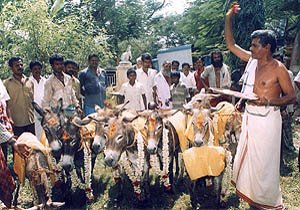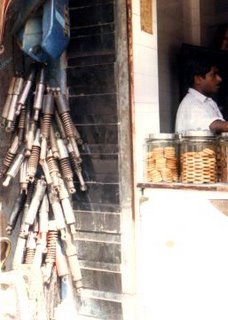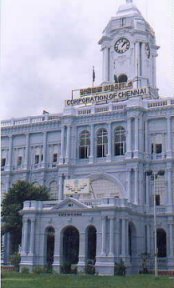I came to India for the first time to study Tamil for two months during a summer vacation. When I was leaving, I bought a book called
Cook and See. It was the translation of a Tamil cookbook called
Samaitthu Paar, which was first published in 1951. I was told that it was presented to Tamil girls when they got married. The author's picture on the back cover made me feel immediately that I was in capable hands.

S. Meenakshi Ammal
I had been staying in a (very) cheap hotel near the wonderful Meenakshi Temple in Madurai. I didn't have a clue about how to cook South Indian food. When I got home I decided to begin with sambar, but the measurements were in ollocks and seers, and the instructions began "Take a stone vessel..." My career as a South Indian cook was stillborn, and the flimsy paperback fell into several pieces.
Recently I was pleased to find that
Cook and See has been modernized and re-issued as
The Best of Samaithu Paar: The Classic Guide to Tamil Cuisine, available from
Penguinbooks India. Here is Meenakshi Ammal's recipe for sambar, the most basic Tamil dish. You can eat this with rice, or idli, or dosai, or wadai... I could eat sambar (almost) every day.
Sambar
Ingredients:
Vegetable 1/4-1/2 kg
New tamarind - a lump the size of a small lime
Red gram dhal (toor dal) 2/3 cup
Turmeric powder 1/2 tsp
Gingelly (sesame) oil 3 tsp (my note: or use any cooking oil)
Dry red chillies 10 (Medium) or 6 (Large)
Green chillies 2
Mustard seeds 1/2 tsp
Fenugreek seeds 1/2 tsp
Asafoetida powder - a pinch or to taste
Curry leaves (Chopped) 3 tbsp
Salt 1 tsp
Rice flour 1/2 tsp
Coriander leaves (Chopped) 3 tbsp
To serve 4 persons
A variety of vegetables -- drumstick, lady's finger (okra), onion, brinjal (eggplant), pumpkin, carrot, French beans, runner beans, etc, -- can be used to prepare sambar. Select any one vegetable. Cut into medium size bits and wash. Vegetables like onion, brinjal, lady's finger, French beans, runner beans and cluster beans can also be fried a little before adding. Amaranth stems, radish, runner beans, cluster beans or pumpkin may be cooked separately with just enough salt and then added.
Soak the tamarind in 1 cup water for 20 minutes. Squeeze it out, adding water little by little to prepare 1 cup of juice.
Choose a heavy vessel, e.g., stoneware, with a very narrow mouth. Wash the dhal. Clean and remove stones, if any. (If the dhal is cleanly husked, it need not be washed.) Boil 1 to 1 1/4 cups of water. Add the dhal, turmeric powder and 1 tsp oil. Cover with a shallow lid, filled with water. (A cup of water may also be placed on the lid.) Add this water to the dhal, if needed,while the dhal is cooking. Cook till very soft. (Some dhals do not cook soon. If so, add a pinch of baking soda. If baking soda is added, do not use turmeric powder, as the colour of the dhal will be spoilt.) Remove from fire and mash the cooked dhal. Keep aside.
Heat a vessel. pour in the remaining oil. Pinch red chillies into halves. Slit green chillies. Fry the pinched red chillies, mustard, fenugreek seeds and asafoetida to a dark brown colour (without blackening it). Add green chillies. Pinch curry leaves and fry for a few moments. Add the tamarind juice to the seasonings with salt. Add the cut and washed vegetable.
When the vegetable is cooked in the tamarind juice, add the mashed dhal. Allow it to boil well. Mix the rice flour in water. Add and stir well. Bring to boil once more. Boil for a few minutes. Remove from fire. Garnish with coriander leaves and a few curry leaves.
Note: Asafoetida water may be used in the place of asafoetida powder. If using asafoetida water, add to the sambar when boiling. To prepare thicker sambar, increase the quantity of dhal. The dhal can be cooked in a pressure cooker as well.
































